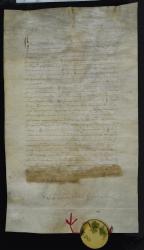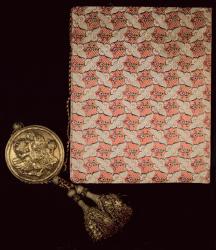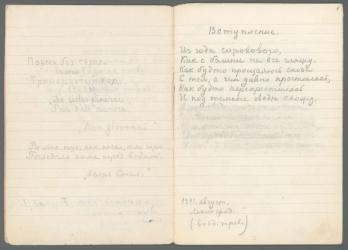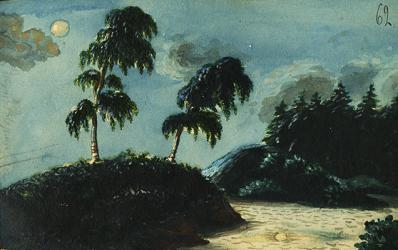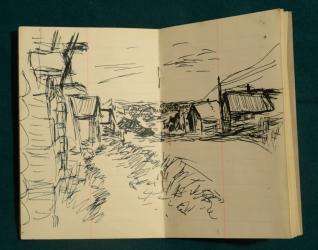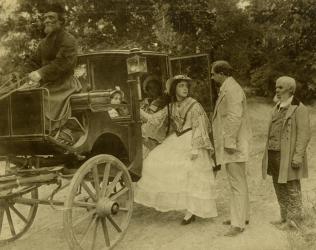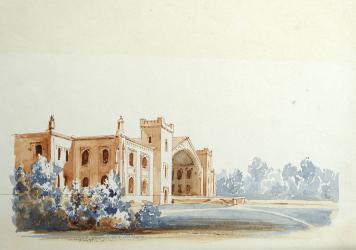Archive Collection
Early Russian Deeds of the 13th to the 19th Centuries
The Manuscript Department possesses more than 20,000 deeds and other documentary material dating from the thirteenth to the nineteenth centuries. They are contained in manuscript books, in personal archives, and form over 40 separate collections. The Library continues to purchase papers from private owners of archival material. Acquired documents represent, mainly, papers from incomplete parts of family archives, but the Department occasionally receives perfect personal archives collected over the period of three or four centuries. These materials are invaluable for research into everyday life in Russia, for study of the history of families and social groups. Thus, they provide a wealth of evidence for anyone interested in the history of nobility state service in the army, navy and public offices.The Manuscript Department holds the rich collection of material, including central and local government records, from archives, maintained by national institutions or local authorities from the sixteenth to the nineteenth centuries. Social, political, economic and religious aspects of the development of the country can be followed through in these documents. Papers, created in connection with the administration of local areas, provide a wonderful resource for local history research into towns and neighbourhood in Russia.
The legal documents mirror the changing cultural processes, the development of the means of production in the era they were produced, and the evolution of paperwork. A medieval document is a small piece of parchment, buckled with ages, with a heavy leaden seal, attached by a linen cord. The text on it is written in an unreadable upright script. The seventeenth century documents are generally in rolls composed of several strips of paper, pasted together end-to-end. Such rolls are written in a departamental cursive script with special flourishes. The other side of the document contains an authenticating official's signature: the absolutely unintelligible writing runs across each juncture of the sheets. The most remarkable of deeds are royal charters and letters patent under the governmental seal. The red or black wax seal is attached by a silver or gold twisted cord, and, sometimes, put into a special bronze box. These documents are richly decorated with bright colours and gold ornaments, and written in fine semi-cursive script. Indeed, the appearence of each document provides significant information regarding its creators and owners, or the place and date of its origins, and reason for production of the document.
Purchase of private archival collections is a major way of developing the holdings. This is done irrespective of time period, place of origin, and language. As a result the Library recieved papers of exceptional range and historical importance. The Manuscript Department is fortunate to own the Trade Treaty of 1269 between Novgorod, that was an important trading center in the Middle Ages, and Riga and Lubeck, regulating terms of trade; diplomatic agreements between different countries devoted to international politics; feudal deeds giving an official proof of ownership of land and serfs; numerous documents relating to national policy in Tsardom of Moscow and Russian Empire etc.
Russian Archives of the 18th to the 19th Centuries
The eighteenth- to twentieth-century Russian archives make up more than half the Manuscripts holdings. These materials represent one of the largest collections of documents on Russian culture, literature, theater, music, and fine arts. They also comprehensively document social, economic, political and scientific aspects of native and European life over three centuries.As the main library of Russia, the Imperial Public Library was the locus of the country's intellectual and cultural values for over a century. Therefore, it managed to assemble the most comprehensive collection of the eighteenth- to twentieth-century century materials on the history of Russia and Russian culture. The National Libraty of Russia has extensive material relating to the House of Romanov from the reign of Peter I to the abdication of Nicholas II, including the autographs of Peter I, the notes of Catherine II, the student notebooks of Paul I, the notebooks of the grand dukes.
The department possesses the archives of many well-known noble families, who played a prominent role in the state, economic, and cultural life of pre-revolutionary Russia. Among them are the local estate libraries of the Yelagin, Kashkar and Mansyrev families; archives of the Bolotov, Buturlin, Vyndomsky, Golenishchev-Kutuzov, Karabanov, Polovtsov, Repinsky families and many others.
The archival stocks contain documents of such statesmen as A. D. Menshikov, the cabinet secretary of Peter I, A. Makarov, Prince G. A. Potemkin, the Russian reformist M. Speransky (2,344 items); the ministers of education A. Golovnin, I. Delianov, A. Norov and I. Tolstoy; heads and officials of other ministries - A. Arakcheev, F. Buxhoeveden, P. Valuyev, G. Willamow, P. Gagarin, A. Golitsyn, K. Grot, S. Zhukovsky, P. Ignatiev, F. Kornilov, V. Kochubei, D. Lobanov-Rostovsky, N. Novosiltsov, N. Panin, F. Pereverzev, V. Plehve, K. Pobedonostsev, A. Polovtsov (1895 items), Ya. Rostovtsev, M. Semevsky, D. Tatishchev, N. Shakhovskaya.
The development of diplomatic relations of the Russian Empire was documented in the materials of the members of the Ministry of Foreign Affairs Emmanouil and Kimon Argyropoulo, A. Budberg, M. Gamazov, A. Gorchakov, S. Destunis, E. Kovalevsky, B. Nolde, N. Orlova, R. Rosen, A. Chernyshev, and G. Chicherin; in the archive of the Rumyantsev family, containing reports and correspondence of the Minister of Foreign Affairs N. Rumyantsev.
Rare autographs of prominent historical figures such as Field Marshal Michael Barclay de Tolly; other heroes of the Napoleonic Wars, Adjutant Generals to Alexander I of Russia: Count Pavel Stroganov and Fiodor Uvarov; the leaders of the Decembrist Revolt of 1825 Kondraty Ryleev, Nikolay Bestuzhev and Pavel Pestel, Wilhelm von Küchelbecker are brought together into the Autographs Collection.
The Manuscripts Department houses one of the largest collections of materials related to the Patriotic War against Napoleon's invasion in 1812. From the first days of a declaration of the war, the Imperial Public Library began to collect official documents, various broadsheets and proclamations. Later, correspondence and memoirs of the campaign participants and their contemporaries were added. The main bodies are concentrated in the collections of commanders and heroes of the Napoleonic Wars Chief Field Marshal Prince Mikhail Kutuzov, General Aleksey Ermolov, Denis Davydov; military historians G. Gabaev, K. Voensky (2 thousand items), A. Mikhailovsky-Danilevsky, N. Schilder.
Historical military documents include the original papers from the personal archives of the direct participants in the events - Generalissimo Alexander Suvorov, Field Marshal Ivan Paskevich, Admirals Samuel and Alexey Greigs, Moisei Argutinsky-Dolgorukov, Alexander Wrangel, Alexande Kazadayev, Woldemar von Lowenstern, Vasily Melikhov and many others. Here one can find reports on events of wars with Sweden, France, all Russo-Turkish wars, the Sinop battle, the defense of Sevastopol, the Russo-Japanese war, the First World War and military operations in the Caucasus.Noteworthy is the collection of the famous navigator, naval commander and research scientist Mikhail Lazarev. Together with Fabian Bellingshausen, he commanded a Russian circumnavigation expedition on the sloops Vostok and Mirny in 1819–1821, which discovered the continent of Antarctica and gave the most valuable materials about the waters and islands of the Antarctic basin and the central parts of the Pacific Ocean. The Department also keeps archives of the participants of geographical and hydrographic expeditions to the northern regions of the country and along the Northern Sea Route — P. Nazimov, N. Sharypov, and B. Nolde.
The National Library of Russia possesses the unigue in terms of the size, value, and range collection of the autographs by Russian writers and poets of the 18th – 21nd centuries, including Mikhail Lermontov, Ivan Turgenev, Nikolay Gogol, Anton Chekhov, Ivan Bunin, Feodor Dostoevsky, Anna Akhmatova. Almost all of the classic Russian, Soviet and modern literature is represented by more than 100 collections and individual items.
For instance, the archive of Mikhail Lermontov, the greatest figure in Russian literature after A. Pushkin, contains the only fair copy of the novel A Hero of Our Time, a rare authorized copy of the poem Demon, several letters and student notebooks of the young poet. A large number of his drawings, sketches of portraits, landscapes increase the value added to handwritten materials of this small archive. Even today the archive stocks are still expanding. There is a strong influx of items from outside Russia. Among those who donated their own material to the National Library of Russia are Prince Gagarin, Baron Nolde and the Nobel-Prize-winning poet Joseph Brodsky.Among the Department's collections that continue to grow, the largest is the Collection of Individual Acquisitions. It embraces the eighteenth- to nineteenth-century handwritten miscellanies consisting of poems and extracts from prose works, documents on the history of Russia, literary manuscripts (poetry, prose, dramaturgy), articles, authors' works on economics, statistics, history, technology, natural science, medicine, literary studies, linguistics, bibliography and bibliography. The extensive section Correspondence includes hundreds of letters.
Constantly updated with new documentary evidence is the Collection of materials about the Second World War, which keeps diaries, memoirs and letters of war veterans and residents of besieged Leningrad.
An indispensable source for studying the historical and political situation in the state, the development of social thought, literary and social life, the moral state of society remains the memoirs literature. The Department has the largest in Russia collection of the eighteenth- to twentieth-century diaries and memoirs written by persons of different professions and different social status.
The history of national theater, cinema and variety art is mirrored by a range of items in the collections of dramatic actors and opera singers, directors, theater artists and administrative workers. Among them are the singers Feodor Chaliapin and Lubov Andreeva- Delmas, the directors Nikolay Akimov and Sergei Radlov, the artists Alexandre Benois and Mstislav Dobuzhinsky,Sergei Diaghilev, the actors Nikolay Monakhov and Nikolay Khodotov, the translator Anna Radlova. Materials on the history of Russian ballet are contained in the collection of outstanding ballet dancers Nataliya Dudinskaya and Konstantin Sergeev, including documents related to the name of the famous choreographer Marius Petipa.Theatrical plays, both original ones and those in translation, assembled by K. Larin, give an idea of the repertoire of the national theater. They number over 1300 dramas, tragedies, comedies, vaudevilles and sketches.
The Imperial Public Library started acquiring visual art objects, including drawings, watercolors, oil works, as soon as it was established in 1795. In various archives and collections, there are illustrations for books and magazines prepared for publication, drawings in albums and on separate sheets. Works of the sixteenth- to twentieth-century native and European artists make up the Collection of Drawings numbering 1,625 items.
Portraits of contemporaries, book graphics, designs, sketches and layouts for books are contained in the personal archives of artists. I. Aivazovsky, N. Altman, A. Bogolyubov, K. Bryullov, Yu. Vasnetsov, G. Vereisky, S. Galaktionov, A. Golovin, V. Konashevich, I. Kramskoy, B. Kustodiev, E. Lancere, V. Makovsky, M. Makhaev, G. Myasoedov, V. Polenov, I. Repin, A. Ryabushkin, N. Stepanov, P. Shtelin - this is not a complete list of the classics of Russian art, whose collections are housed in the Manuscripts Department.
Valuable resources for the restoration work are drawings of the fine examples of the Russian architecture in the cities of Izborsk, Novgorod, Ostrov and Pskov, as well as watercolor pictures of Novgorod frescoes partially lost during the World War II, made by E. Evenbach (1920) and S. Steinberg (1939 - 1940).Graphic materials are supplemented by the collections of the sculptors Mark Antokolsky and Ilya Gunzburg, architects Nicholas and Leon Benois, Giacomo Quarenghi, Alexander Nikolsky and Miron Roslavlev, art historians Nikolai Sobko, Vsevolod Petrov, Dmitry Rovinsky, Erich Hollerbach, Igor Myamlin. These collections attract the attention of not only art experts, but also historians, book lovers, restorers.
View the virtual exhibitions:
Materials Relating to M. Petipa's Ballets
Pictures of Mikhail Lermontov (in Russian)
